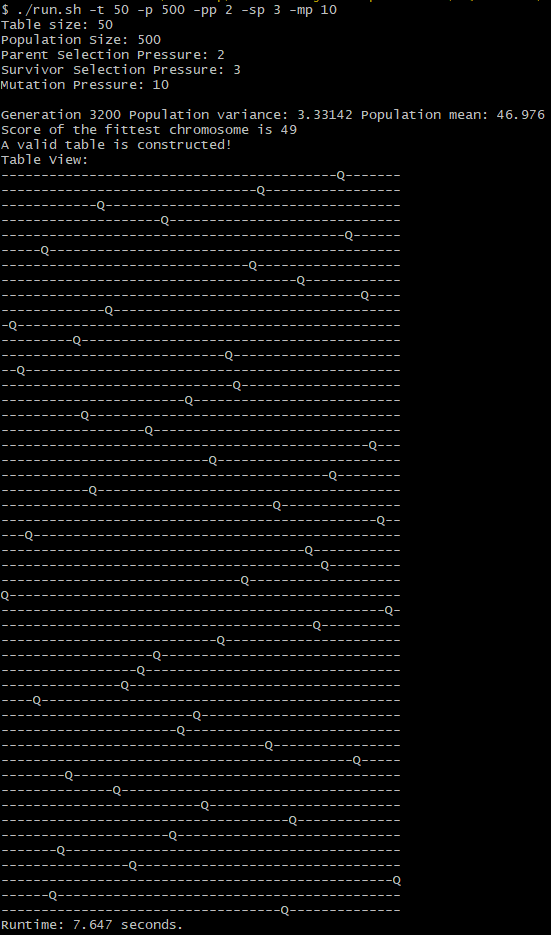I implemented a genetic algorithm for the N-Queens problem with several improvements. This implementation can be a reference point for further developments or a helper to implement algorithms for harder NP problems. GA code is written in C++.
To improve the algorithm, a tuner must be developed for different input sizes. For example, the algorithm can find a optimal solution in a negligible time time for N=35 but can get stuck at a local optimum for N=36. This issue can be overcome by developing a good tuner for the algorithm parameters.
Currently, the algorithm has ordinary components of GA. In addition to these, it has a static adaptation feature. Moreover, a dynamic adaptation(self-adaptation) algorithm would be developed if the problem had dynamic constraints and parameters.
An individuals(chromosome) genetics is constructed by permutations. For example, for a N=4 table, a sample individual may have the following sequence:
2413 which represents the following table:
-Q--
---Q
Q---
--Q-
The algorithm consists of the following selection mechanisms:
- Random Parent Selection
- Tournament Parent Selection
- Crowding Survivor Selection
- Random Survivor Selection
- Elitist Survivor Selection (currently not used)
The algorithm uses crossover operation to generate new individuals:
Crossover types:
- Cut And Crossfill Crossover
- Uniform Crossover
Mutation is simply done by swapping genes of an individual.
Individuals fitness scores are calculated by counting how many queens check each other. For example, for a N=15 individual if 5 queens check each other then its fitness score will be 10 by the following equation:
Fitness = N - queen checks
In every new generation, a population variance is calculated and adaptation algorithm makes decisions between different approaches based on the population variance. The algorithm will check selection and mutation pressure to make the decisions. For example, if the population variance is 1 and mutation pressure 1.5, algorithm will make the decision of mutating by the following statement:
population variance < mutation pressure
The algorithm also checks for parent and survivor selections. This provides a solution to the problem of over selection. Usually, the adaptation algorithm balances the system with two basic search behaviors: Exploration and exploitation.
The following code block explains this approach for survival selection:
if (populationVariance < survivalSelectionPressure)
{
// Exploration
survivors = randomSurvivorSelection(parents, children);
}
else
{
// Exploitation
survivors = crowdingSurvivalSelection(parents, children);
}Currently, I created a tuning csv file for different size of inputs. In the future, I will develop a tuner by using the data in that file.
| TableSize(N) | PopSize | ParentSelectionPressure | SurvivorSelectionPressure | MutationPressure | ExecutionTime |
|---|---|---|---|---|---|
| 20 | 120 | 0.2 | 0.5 | 1.2 | 0.2s |
| 21 | 147 | 0.2 | 0.5 | 1.2 | 0.3s |
| 25 | 250 | 2 | 3 | 10 | 0.2s |
| 30 | 510 | 1 | 0.5 | 2 | 2.2s |
| 40 | 400 | 2 | 3 | 10 | 1.7s |
| 50 | 500 | 2 | 3 | 10 | 5.3s |
build/run.sh script will run the algorithm after compilation.
The script must run with specified arguments. An example may be like:
$ ./run.sh -t 20 -p 200 -pp 2 -sp 1 -mp 5
[1] Eiben, A. and Smith, J., 2015. Introduction to Evolutionary Computing. 2nd ed. Berlin: Springer.

